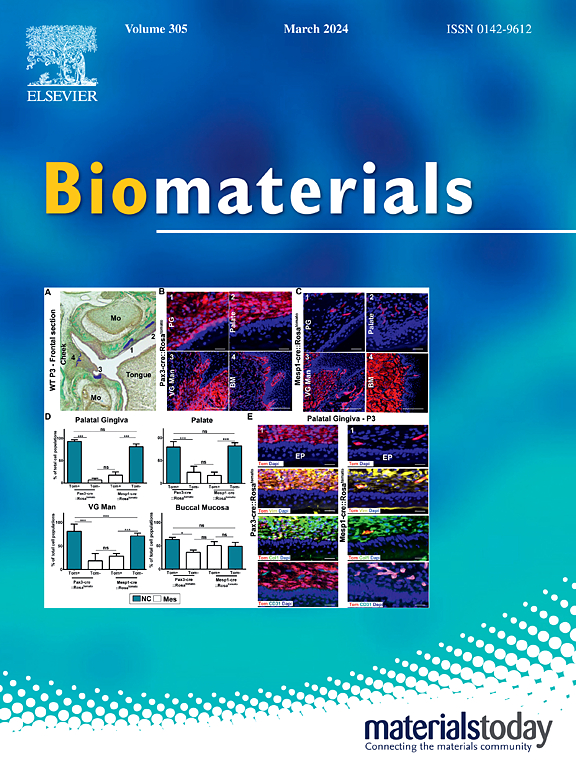Direct extrusion of multifascicle prevascularized human skeletal muscle for volumetric muscle loss surgery
IF 12.8
1区 医学
Q1 ENGINEERING, BIOMEDICAL
引用次数: 0
Abstract
Skeletal muscle is composed of multiple fascicles, which are parallel bundles of muscle fibers surrounded by connective tissues that contain blood vessels and nerves. Here, we fabricated multifascicle human skeletal muscle scaffolds that mimic the natural structure of human skeletal muscle bundles using a seven-barrel nozzle. For the core material to form the fascicle structure, human skeletal myoblasts were encapsulated in Matrigel with calcium chloride. Meanwhile, the shell that plays a role as the connective tissue, human fibroblasts and human umbilical vein endothelial cells within a mixture of porcine muscle decellularized extracellular matrix and sodium alginate at a 95:5 ratio was used. We assessed four types of extruded scaffolds monolithic-monoculture (Mo-M), monolithic-coculture (Mo–C), multifascicle-monoculture (Mu-M), and multifascicle-coculture (Mu-C) to determine the structural effect of muscle mimicking scaffold. The Mu-C scaffold outperformed other scaffolds in cell proliferation, differentiation, vascularization, mechanical properties, and functionality. In an in vivo mouse model of volumetric muscle loss, the Mu-C scaffold effectively regenerated the tibialis anterior muscle defect, demonstrating its potential for volumetric muscle transplantation. Our nozzle will be further used to produce other volumetric functional tissues, such as tendons and peripheral nerves.
直接挤压多层前血管化人体骨骼肌,用于肌肉体积损失手术
骨骼肌由多个筋束组成,这些筋束是平行的肌肉纤维束,周围是含有血管和神经的结缔组织。在这里,我们使用七管喷嘴制造了多束人体骨骼肌支架,模拟了人体骨骼肌束的天然结构。作为形成束状结构的核心材料,人体骨骼肌母细胞被包裹在含有氯化钙的 Matrigel 中。同时,作为结缔组织的外壳,使用了猪肌肉脱细胞细胞外基质和海藻酸钠以 95:5 的比例混合而成的人成纤维细胞和人脐静脉内皮细胞。我们评估了四种挤压支架:单层单细胞培养(Mo-M)、单层单细胞培养(Mo-C)、多层单细胞培养(Mu-M)和多层单细胞培养(Mu-C),以确定肌肉模拟支架的结构效果。Mu-C支架在细胞增殖、分化、血管化、机械性能和功能性方面均优于其他支架。在体内小鼠体积肌肉缺失模型中,Mu-C 支架有效地再生了胫骨前肌缺损,证明了它在体积肌肉移植方面的潜力。我们的喷嘴将进一步用于生产其他体积功能组织,如肌腱和周围神经。
本文章由计算机程序翻译,如有差异,请以英文原文为准。
求助全文
约1分钟内获得全文
求助全文
来源期刊

Biomaterials
工程技术-材料科学:生物材料
CiteScore
26.00
自引率
2.90%
发文量
565
审稿时长
46 days
期刊介绍:
Biomaterials is an international journal covering the science and clinical application of biomaterials. A biomaterial is now defined as a substance that has been engineered to take a form which, alone or as part of a complex system, is used to direct, by control of interactions with components of living systems, the course of any therapeutic or diagnostic procedure. It is the aim of the journal to provide a peer-reviewed forum for the publication of original papers and authoritative review and opinion papers dealing with the most important issues facing the use of biomaterials in clinical practice. The scope of the journal covers the wide range of physical, biological and chemical sciences that underpin the design of biomaterials and the clinical disciplines in which they are used. These sciences include polymer synthesis and characterization, drug and gene vector design, the biology of the host response, immunology and toxicology and self assembly at the nanoscale. Clinical applications include the therapies of medical technology and regenerative medicine in all clinical disciplines, and diagnostic systems that reply on innovative contrast and sensing agents. The journal is relevant to areas such as cancer diagnosis and therapy, implantable devices, drug delivery systems, gene vectors, bionanotechnology and tissue engineering.
 求助内容:
求助内容: 应助结果提醒方式:
应助结果提醒方式:


